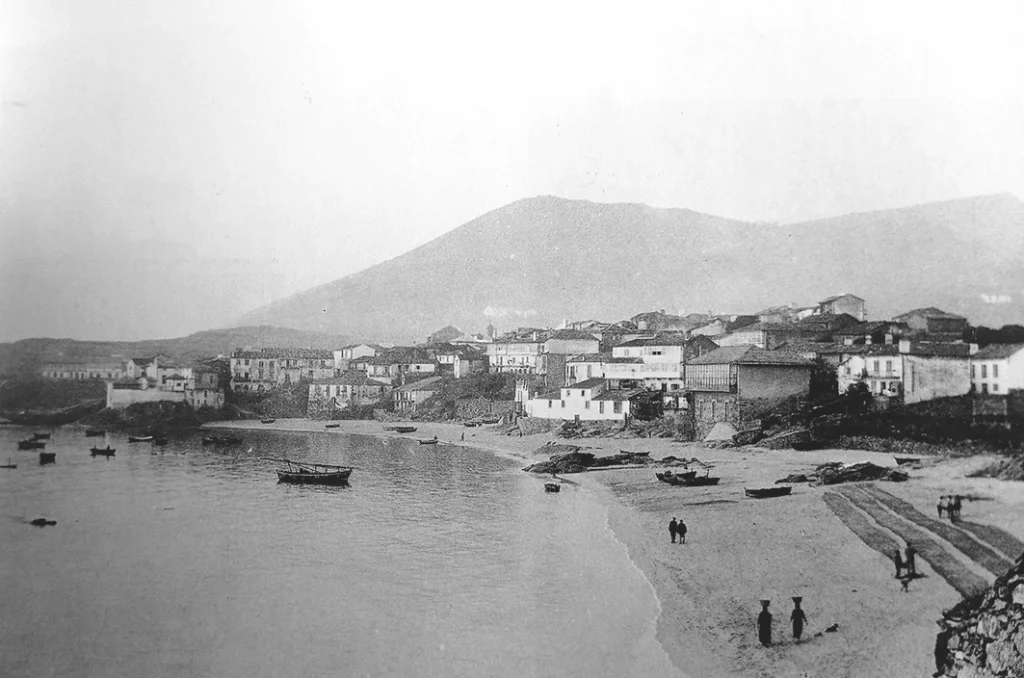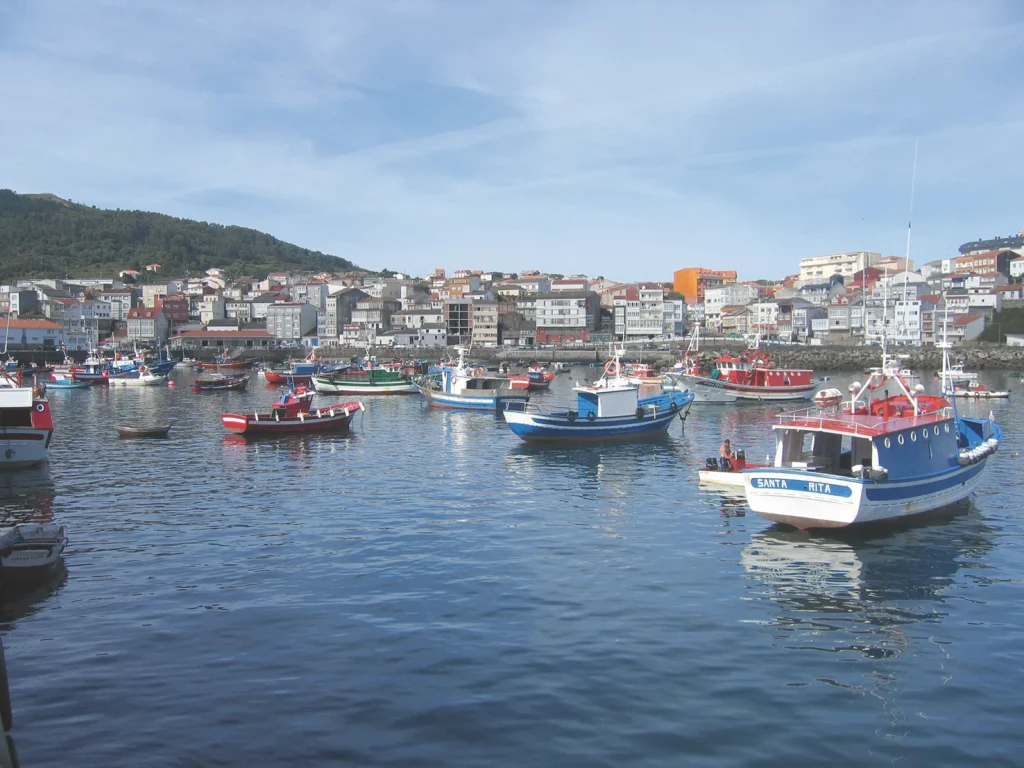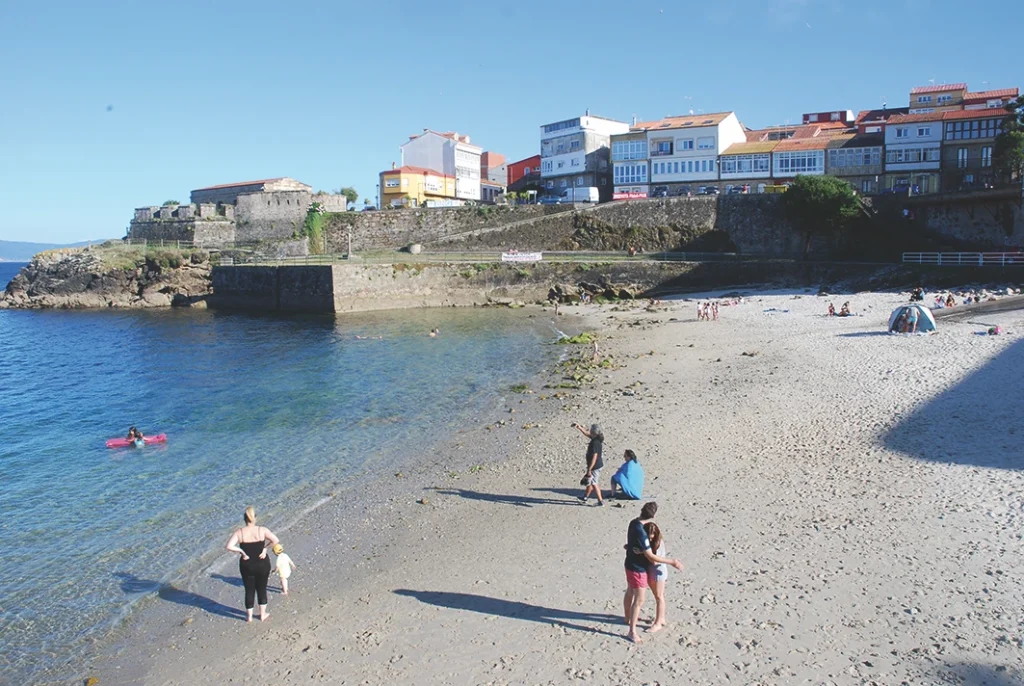History
The good conditions offered by this part of the coast where Fisterra stands today have always made it an ideal location for settlement since prehistoric times, although there is no data to confirm this. The town was established in the Middle Ages as a centre for trade and fishing.

In the mid-16th century, besides the parish church of Santa María das Areas, Fisterra was also home to three shrine: San Guillerme, on the slopes of the hill with the same name; Santa Catalina, on the street with the same name and San Roque, at the entrance to the town, near the calvary of A Cruz de Baixar. There was also a pilgrims’ hospital opposite the parish church, founded by a parish priest, Alonso García, in 1469.
Fisterra had been attacked by foreign pirates since the Middle Ages, first by Normans and Muslims, and then by the English and French. French pirates attacked the town in 1552 and looted the shrine of San Guillerme. Cardinal Del Hoyo states in his memoirs of the 17th century that they stole the saint’s remains and a reliquary with one of the saint’s arms that was kept in the parish church. He also mentions that the population of the town at the time consisted of sixty persons who all earned a living from fishing, were very poor and whose homes had been burned down on several occasions.
Fisterra was invaded by French troops in 1809, who looted the town and set fire to the castle of San Carlos. Seeing that it was impossible to resist the invaders, many of the residents took to the sea in boats and protected themselves in the ría.
By the early 20th century, Fisterra had become a large town with over two thousand inhabitants who worked in fishing and used the beaches of A Ribeira and Calafigueira to moor their boats. The town had salting factories, a thriving business community, leisure associations and a fishermen’s cooperative.
The oldest houses were situated around the beach of A Ribeira as a natural harbour. The town itself was made up of two districts: the oldest, called Cabo da Xesta, had a main road that started in the Praciña Ara Solis, passed through the Praza de la Constitución and then continued along the Rúa Real. The other more modern district was called Cabo da Vila and the high street was called Rúa Santa Catalina, which went to the town hall and the outskirts. The districts were separated by the Regato Mixirica, a stream that is now channelled and covered by a street, Rúa Federico Ávila, which is the main road that leads to the port.
In the 1920s, Carré Aldao, a local writer, described Fisterra as a town with regular streets and well built houses, quite unlike the picture drawn by the English travel writer, Aubrey F. G. Bell, who said that the houses looked miserable and that the streets were unkempt and full of rubbish.5

Present-day Fisterra is a very different town from the one it was one hundred years ago. Although it still conserves a sizeable part of the old structure, most of the houses are newly built or restored. The greatest changes have been made to the port area, where fishing and tourism is mostly concentrated. The most striking building is the new fish auction hall, designed by the architect Juan Creus, where the catches of the fishing fleet are sold off every day.
– Route on foot around the town The route starts at the harbour esplanade and takes you on a tour to discover the town. A walk around the harbour allows you to see all the port facilities, the ships that fill the port’s waters with colour and the many bars and restaurants and their terraces. The fish auction hall can be found in the broad open space of the harbour, where much of the fishing activity takes place. A huge anchor painted black can be seen in the same area. A closer look shows that the anchor is a reference to the sinking of Casón, a vessel sailing under the Panamanian flag that ran aground on this coast in 1987 and caused panic amongst local residents because of the dangerous cargo on board.
The beach of A Ribeira is behind the port: a small bay that used to be a mooring space and is now an urban beach. The oldest houses in the town surrounded this small and sheltered bay, but now little remains of them. One of the few to remain is notable for having an entrance with a pointed arch as a reminder of medieval Fisterra. On some cliffs at the south end of the bay is the Castle of San Carlos, one of the four fortresses commissioned by the Bourbons to defend this coast in the mid-18th c. and designed by the French engineer, Carlos Lemaur. The irregular shape of the perimeter wall is caused by the rocks on which it stands.

The embrasures face in three directions: cape Fisterra, the centre of the ría and the town itself. There is a building inside with space for a small garrison. The castle was razed during the French invasion. It was later purchased by a local businessman in the late 19th century, Plácido Castro Rivas, who donated the building to the town hall of Fisterra to build a school, but the project never came to fruition due to a lack of funds. Plans were also made in the postwar period to convert it into a museum, which likewise never saw the light of day. The building changed hands on several occasions and was put to different uses until the Fishermen’s Guild gathered enough funds to create the Fishing Museum in 2006, which opened its doors two years later. Since then, it has received more than 100,000 visitors who have had the chance to listen to the interesting explanations of the museum guide and well-known local poet Francisco Manuel López Martínez, who signs his work with the pseudonym Alexandre Nerium. Any visitor to Fisterra should pay a visit to this small but fascinating museum.
From the Castle of San Carlos you now head off to the Praza de Ara Solis to see the chapel of Buen Suceso, founded by the parish priest Mateo Pérez Porrúa in 1743, and built in the Baroque style, as the façade clearly shows. The altarpiece of the main chapel, likewise built in the same style, is presided over by the Virgin of Succour. The calvary and font nearby complement the structure.
The plaza also has an old house with a coat of arms and sundial that date back to the early 17th century and symbolise the presence of nobility in the town. Now head off down the main street to the Praza da Constitución, the centre of the old town, where some houses of local businessmen can still be seen, with balconies or galleries, unlike the humbler fishermen’s houses. Continue along Rúa Real, the town’s high street, until you reach the street that goes down to the port. On the left hand corner you can see the pilgrims’ hostel, built in 2001 to provide accommodation to the many pilgrims who come to Fisterra. If you head straight down along Rúa Santa Catalina, you’ll come to the town hall building and the road leading out of the town.
The high road crosses the town from east to west and has different names along the way. It used to be the old road that went to the parish church and the lighthouse. Fisterra grew around this street and became the centre for commercial, cultural and leisure activity. It was crossed at right angles by small streets or lanes that went down to the shore, where all the fishing activity took place. The town’s appearance changed after the construction of the new port area and the opening of the new road to the lighthouse.